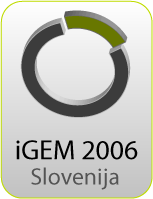Ljubljana, Slovenia 2006/Terms & References
From 2006.igem.org
(Difference between revisions)
Revision as of 14:41, 28 October 2006
| Home | Background and Signalling Pathway | Project | Methods | Results & Conclusions | Team members |
|---|
Terms
- CpG</dt>
- Unmethylated CpG motifs usually present in bacterial DNA. They are recognised by TLR9 receptor.</dd>
- Dominant negative protein</dt>
- A protein that is mutated in a way that it competes with wild type protein, but does not support the cascade of additional interactions downstream. This result in a blocking of the pathway.</dd>
- ERK kinases</dt>
- Extracellular signal-regulated kinases (ERKs) are regulatory proteins that mediate cell survival, proliferation, and differentiation.</dd>
- Flagellin</dt>
- This protein can be found in bacterial flagellae. It arranges itself in a hollow cylinder to form the filament in bacterial flagellum.</dd>
- HEK293</dt>
- Human embryonic kidney epithelial cell line, that was generated by transformation of human embryonic kidney cell cultures (hence HEK) with sheared adenovirus 5 DNA.</dd>
- LPS</dt>
- LPS stands for lipopolysaccharide. It is a characteristic component of bacterial cell walls....</dd>
- MD2</dt>
- MD2 is an essential protein component that stabilizes TLR4. It has a critical role LPS linking to the LPS receptor.</dd>
- MyD88</dt>
- A central protein of the TLR signaling pathway that transfers signal from TLR receptor to downstream proteins (IRAK4) resulting in the NFκB activation. MyD88 is composed of TIR domain, with which it interacts with TIR domains of TLRs and of a death domain, which interacts with heteromeric death domains of IRAK kinases. Truncated MyD88, comprising only of TIR domain has a dominant-negative phenotype (dnMyD88), because it interacts with cytoplasmic domain of TLRs and competes with wild type MyD88. Because of the lack of a death domain dnMyD88 does not support the cell signaling.</dd>
- NFκB</dt>
- A transcription factor that functions as heterodimer. NFκB dimers are usually sequestered in the cytoplasm in an inactive form. Activation of NFκB involves phosphorylation and proteolysis of the inhibitory IκB proteins, release and nuclear translocation of the NFκB, which results in activation of NFκB-dependent transcription.</dd>
- PEST sequence</dt>
- This is a sequence that has been associated with rapidly degraded proteins. The short life-time of a protein is signaled by a region rich in the amino acids proline (P); glutamic acid (E); serine (S); or threonine (T).</dd>
- TLR 4</dt>
- Member of TLR receptor familiy that is predominantly activated by lipopolysaccharide. It can activate MyD88 dependent and independent way. For activation also MD2 and CD14 accessory molecules are needed. </dd>
- TRAF6</dt>
- A protein that functions as a signalling mediator. It binds to IRAK1 and transfers signal downstream, also resulting in NF-kappaB activation.</dd>
References
| Home | Background and Signalling Pathway | Project | Methods | Results & Conclusions | Team members |
|---|
</center>
